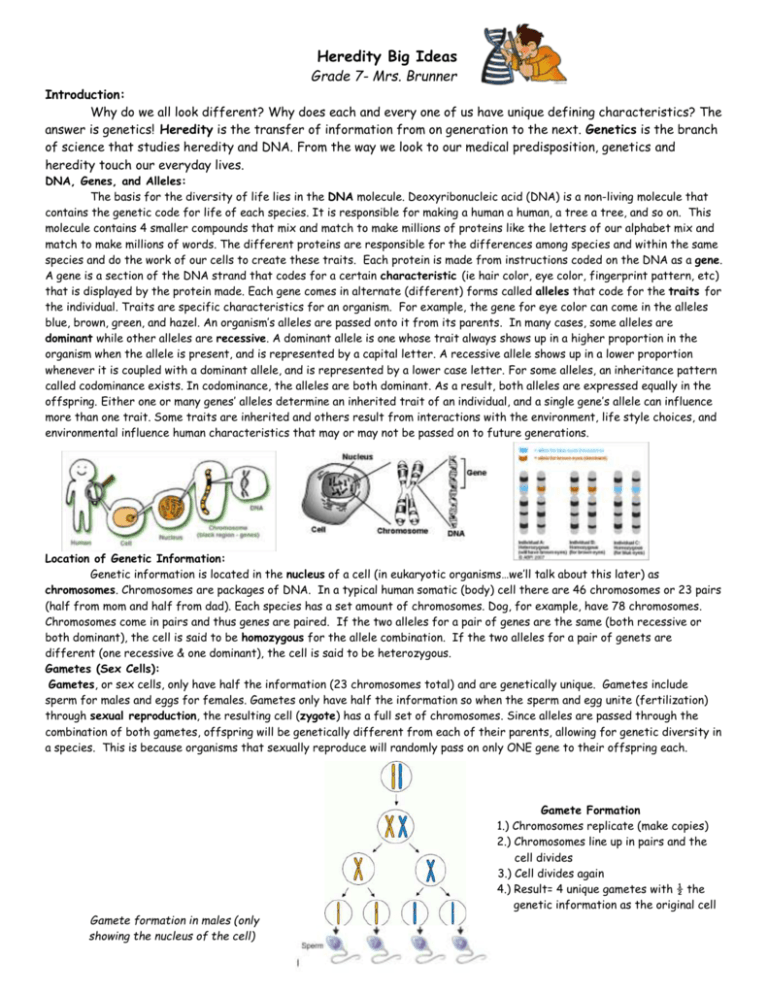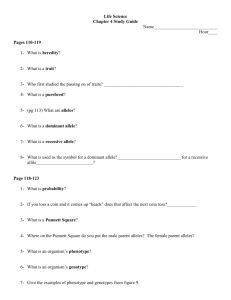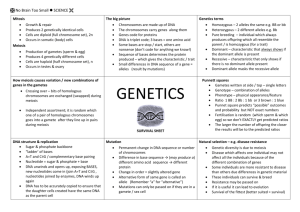Study Guide for Test #1
advertisement

Heredity Big Ideas Grade 7- Mrs. Brunner Introduction: Why do we all look different? Why does each and every one of us have unique defining characteristics? The answer is genetics! Heredity is the transfer of information from on generation to the next. Genetics is the branch of science that studies heredity and DNA. From the way we look to our medical predisposition, genetics and heredity touch our everyday lives. DNA, Genes, and Alleles: The basis for the diversity of life lies in the DNA molecule. Deoxyribonucleic acid (DNA) is a non-living molecule that contains the genetic code for life of each species. It is responsible for making a human a human, a tree a tree, and so on. This molecule contains 4 smaller compounds that mix and match to make millions of proteins like the letters of our alphabet mix and match to make millions of words. The different proteins are responsible for the differences among species and within the same species and do the work of our cells to create these traits. Each protein is made from instructions coded on the DNA as a gene. A gene is a section of the DNA strand that codes for a certain characteristic (ie hair color, eye color, fingerprint pattern, etc) that is displayed by the protein made. Each gene comes in alternate (different) forms called alleles that code for the traits for the individual. Traits are specific characteristics for an organism. For example, the gene for eye color can come in the alleles blue, brown, green, and hazel. An organism’s alleles are passed onto it from its parents. In many cases, some alleles are dominant while other alleles are recessive. A dominant allele is one whose trait always shows up in a higher proportion in the organism when the allele is present, and is represented by a capital letter. A recessive allele shows up in a lower proportion whenever it is coupled with a dominant allele, and is represented by a lower case letter. For some alleles, an inheritance pattern called codominance exists. In codominance, the alleles are both dominant. As a result, both alleles are expressed equally in the offspring. Either one or many genes’ alleles determine an inherited trait of an individual, and a single gene’s allele can influence more than one trait. Some traits are inherited and others result from interactions with the environment, life style choices, and environmental influence human characteristics that may or may not be passed on to future generations. Location of Genetic Information: Genetic information is located in the nucleus of a cell (in eukaryotic organisms…we’ll talk about this later) as chromosomes. Chromosomes are packages of DNA. In a typical human somatic (body) cell there are 46 chromosomes or 23 pairs (half from mom and half from dad). Each species has a set amount of chromosomes. Dog, for example, have 78 chromosomes. Chromosomes come in pairs and thus genes are paired. If the two alleles for a pair of genes are the same (both recessive or both dominant), the cell is said to be homozygous for the allele combination. If the two alleles for a pair of genets are different (one recessive & one dominant), the cell is said to be heterozygous. Gametes (Sex Cells): Gametes, or sex cells, only have half the information (23 chromosomes total) and are genetically unique. Gametes include sperm for males and eggs for females. Gametes only have half the information so when the sperm and egg unite (fertilization) through sexual reproduction, the resulting cell (zygote) has a full set of chromosomes. Since alleles are passed through the combination of both gametes, offspring will be genetically different from each of their parents, allowing for genetic diversity in a species. This is because organisms that sexually reproduce will randomly pass on only ONE gene to their offspring each. Gamete formation in males (only showing the nucleus of the cell) Gamete Formation 1.) Chromosomes replicate (make copies) 2.) Chromosomes line up in pairs and the cell divides 3.) Cell divides again 4.) Result= 4 unique gametes with ½ the genetic information as the original cell As mentioned before, the alleles that are passed on through sexual reproduction, code for proteins. Protein synthesis, or the making of proteins, starts in the nucleus of the cell with the DNA (chromosomes). 1.) The allele (gene) for the protein that needs to be made is copied onto a piece of RNA (we’ll talk about RNA later) called messenger RNA (mRNA). 2.) Messenger RNA then leaves the nucleus out into the cytoplasm of the cell to the ribosomes. Ribosomes are the sites of protein synthesis. 3.) The ribosomes read the instructions coded on the messenger RNA and 4.) take amino acids (the building blocks of proteins) and string them together to make a specific protein that will help the cell determine its traits. Once again, the trait coded by allele that is considered the dominant allele will show up in a greater proportion in the organism by the proteins made. Overall protein synthesis can be summarized by the following: DNA (nucleus) Messenger RNA Protein (ribosome) 1 2 3 4








